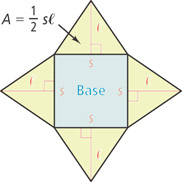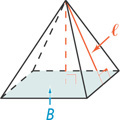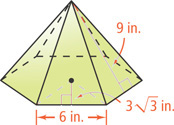 Dynamic Activity
Dynamic Activity
Surface and Lateral Areas of Pyramids and Cones
The lateral area of a pyramid is the sum of the areas of the congruent lateral faces. You can find a formula for the lateral area of a pyramid by looking at its net.

To find the surface area of a pyramid, add the area of its base to its lateral area.
Take note Theorem 11-3: Lateral and Surface Areas of a Pyramid
The lateral area of a regular pyramid is half the product of the perimeter p of the base and the slant height l of the pyramid.

The surface area of a regular pyramid is the sum of the lateral area and the area B of the base.
 Problem 1 Finding the Surface Area of a Pyramid
Problem 1 Finding the Surface Area of a Pyramid
What is the surface area of the hexagonal pyramid?

Think
What is B?
B is the area of the base, which is a hexagon. You are given the apothem of the hexagon and the length of a side. Use them to find the area of the base.
The surface area of the pyramid is about
✓ Got It?
-
- A square pyramid has base edges of 5 m and a slant height of 3 m. What is the surface area of the pyramid?
- Reasoning Suppose the slant height of a pyramid is doubled. How does this affect the lateral area of the pyramid? Explain.
When the slant height of a pyramid is not given, you must calculate it before you can find the lateral area or surface area.
Table of Contents
- 6-1 The Polygon Angle-Sum Theorems
- 6-2 Properties of Parallelograms
- 6-3 Proving That a Quadrilateral Is a Parallelogram
- 6-4 Properties of Rhombuses, Rectangles, and Squares
- 6-5 Conditions for Rhombuses, Rectangles, and Squares
- 6-6 Trapezoids and Kites
- 6-7 Polygons in the Coordinate Plane
- 6-8 and 6-9 Coordinate Geometry and Coordinate Proofs




